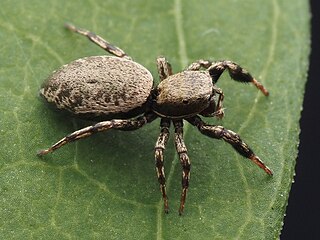
Phidippus cardinalis is a species of jumping spider. It is commonly called cardinal jumper. It is one of the species of jumping spiders which are mimics of mutillid wasps in the genus Dasymutilla ; several species of these wasps are similar in size and coloration to the spiders, and possess a very painful sting.

Marchena is a genus of jumping spiders only found in the United States. Its only described species, M. minuta, dwells on the barks of conifers along the west coast, especially California, Washington and Nevada.

Talavera is a genus of very small jumping spiders that was first described by George and Elizabeth Peckham in 1909. They average about 2 millimetres (0.079 in) in length, and are very similar to each other. In particular, the Central European species are difficult to distinguish, even when their genital features are studied under a microscope. The name refers to Talavera, a region of Spain where many have been found.

Marpissa pikei is a species of jumping spider that is found in the eastern United States, Texas, New Mexico, Arizona and Cuba.

Anasaitis canosus, previously of the genus Corythalia, is a small jumping spider that can typically be found atop leaf-litter or man-made structures such as fences and exterior walls. This species is more commonly known as the twin-flagged jumping spider due to the two pennant shaped markings on the dorsal side of the cephalothorax. Typical of the genus Anasaitis, this species has iridescent setae ("scales") which may appear white, green or pink which create the "flags" as well as patches on the male pedipalps used in courtship and intraspecific signaling. This species is roughly 5 to 6 mm in length. A. canosus ranges from Mexico to South Carolina along the Gulf of Mexico.

Habronattus pyrrithrix is a species of jumping spider in the family Salticidae. It is found in the southwestern United States and western Mexico.

Habronattus cognatus is a species of jumping spider. It is found in North America.

Phidippus insignarius is a species of jumping spider in the family Salticidae. It is found in the United States.

Phidippus texanus is a species of jumping spider in the family Salticidae. It is found in the United States and Mexico.

Salticus austinensis, the zebra spider, is a species of jumping spider. It is found in the United States, Mexico, and Central America.

Habronattus orbus is a species of jumping spider in the family Salticidae. It is found in the United States.

Habronattus texanus is a species of jumping spider in the family Salticidae. It is found in the United States and Mexico.

Phidippus carolinensis is a species of jumping spider. It is found in the United States and Mexico.

Marpissa formosa is a species of jumping spider. It is found in the eastern United States.

Tutelina harti is a species of jumping spider. It is found in the United States and Canada.

Chalcoscirtus diminutus is a species of jumping spider in the family Salticidae. It is found in the United States.

Asemonea pinangensis is a species of jumping spider in the genus Asemonea that is endemic to Malaysia. The spider was first defined in 1980 by Fred Wanless. It is a small spider, with a carapace that is typically 1.16 mm (0.046 in) long and an abdomen typically 1.2 mm (0.047 in) long. The carapace is whitish-yellow with black markings and the abdomen black with whitish-yellow markings. The coloration, as well as the lip on its dorsal tibial apophysis, help distinguish the species from the otherwise similar Asemonea maculata, Asemonea minuta and Asemonea tanikawai. The female has not been described.

Hentzia palmarum, the common hentz jumper, is a species of jumping spider in the family Salticidae. It is found in North America, Bermuda, the Bahamas, and Cuba.

Irura bidenticulata, commonly known as the purple-gold jumping spider, is a species of salticid. As the name implies, while females tend to take on a more dull coloration, males are characterized by their striking, shiny magenta-gold patterned bodies. Discovered in 2011, the spider had initially been mistaken for a member of the Simaetha genus. Native to regions of Southeast Asia, it was first spotted in Hainan, China, having since also been located in the Saraburi province of Thailand, Cambodia, Hong Kong, and Assam.
Pochyta minuta is a species of jumping spider in the genus Pochyta that lives in Nigeria. It was first described in 2021 by Wanda Wesołowska and Tamás Szűts. A small spider, it has a cephalothorax that is typically 2.3 mm long and an abdomen 2.66 mm long. The cephalothorax is generally yellow apart from its black rings around the spider's eyes and a grey v-shaped marking on the carapace, or hard top shell. The abdomen is greyish-brown on top with a herring-bone pattern to the rear. The spider has long legs long brown spines. The female has a small epigyne, which is recalled in the species name that means "tiny". Internally, the spider's copulatory organs are similar to the related Pochyta pulchra. The male has not been described.
























